Unsteady Flow Field Analysis of a Compressor Cascade Based on Dynamic Mode Decomposition
Abstract
1. Introduction
2. DMD Method
2.1. Fundamental Concept of DMD
2.2. DMD Algorithm
3. Airfoil Case Study
3.1. DMD Modal Analysis of Airfoil Case
3.2. DMD Modal Contour Plot of Airfoil Case
3.3. Reconstruction of Airfoil Case
3.4. Error Analysis of Airfoil Case
4. Compressor Cascade Analysis
4.1. Research Object
4.2. DMD Modal Analysis
4.3. DMD Modal Contour Plot
4.4. Reconstruction
4.5. Error Analysis
5. Conclusions
- The DMD analysis of the unsteady flow field of the Stage35 compressor cascade verified the effectiveness of the DMD method in addressing complex flow problems. The results show that the first six modes captured the majority of the system’s energy, effectively capturing the primary dynamic behavior of the flow field;
- Using the dominant DMD modes obtained from the decomposition, the flow field was reconstructed. The contour plots generated from the reconstructed data for both the pressure field and the Mach number field closely match the original flow field, indicating that the DMD modes can accurately reproduce the primary structures in the flow field;
- Through error analysis, we found that the overall reconstruction error when using DMD was relatively low, with higher errors only occurring in regions with complex flow structures. Future work can focus on optimizing the DMD method to improve the reconstruction accuracy in these regions.
Author Contributions
Funding
Data Availability Statement
Conflicts of Interest
References
- Zhang, L.; Deng, X.; He, L.; Li, M.; He, X. The opportunity and grand challenges in computational fluid dynamics by exascale computing. Acta Aerodyn. Sin. 2016, 34, 405–417. [Google Scholar] [CrossRef]
- Pearson, K.L., III. On lines and planes of closest fit to systems of points in space. Lond. Edinb. Dublin Philos. Mag. J. Sci. 1901, 2, 559–572. [Google Scholar] [CrossRef]
- Hotelling, H. Analysis of a complex of statistical variables into principal components. J. Educ. Psychol. 1933, 24, 417. [Google Scholar] [CrossRef]
- Lu, K.; Jin, Y.; Chen, Y.; Yang, Y.; Hou, L.; Zhang, Z.; Li, Z.; Fu, C. Review for order reduction based on proper orthogonal decomposition and outlooks of applications in mechanical systems. Mech. Syst. Signal Process. 2019, 123, 264–297. [Google Scholar] [CrossRef]
- Fogleman, M.; Lumley, J.; Rempfer, D.; Haworth, D. Application of the proper orthogonal decomposition to datasets of internal combustion engine flows. J. Turbul. 2004, 5, 023. [Google Scholar] [CrossRef]
- Zhu, J.; Huang, G.; Fu, X. Spatiotemporal characteristics analysis for controlling flow separation in divergent curved channels with POD method. Acta Aeronaut. Astronaut. Sin. 2014, 35, 921–932. [Google Scholar] [CrossRef]
- Dong, S.; Shi, A.; Ye, Z.; Tian, H. CFD computation and POD analysis for transonic buffet on a supercritical airfoil. Acta Aerodyn. Sin. 2015, 33, 481–487. [Google Scholar] [CrossRef]
- Hall, K.C.; Thomas, J.P.; Dowell, E.H. Proper orthogonal decomposition technique for transonic unsteady aerodynamic flows. AIAA J. 2000, 38, 1853–1862. [Google Scholar] [CrossRef]
- Chen, L.; Xu, C.; Lu, X. Numerical investigation of the compressible flow past an aerofoil. J. Fluid Mech. 2010, 643, 97–126. [Google Scholar] [CrossRef]
- Yu, H.; Chen, Y. Application of POD method to reduce dimensions of rotor system. J. Harbin Univ. Commer. Nat. Sci. Ed. 2012, 28, 365–368. [Google Scholar] [CrossRef]
- Chen, K.; Zhang, Y.; Lei, Y.; Lu, A.; Zhang, D. Wake analysis of pulsed jet based on proper orthogonal decomposition. Chin. J. Appl. Mech. 2022, 39, 834–844. [Google Scholar] [CrossRef]
- Zhang, Y.; Wang, Z.; Qiu, R.; Xi, G. Improved POD-Galerkin reduced order model with long short-term memory neural network and its application in flow field prediction. J. Xi’an Jiaotong Univ. 2024, 58, 12–21. [Google Scholar] [CrossRef]
- Kou, J. Reduced-Order Modeling Methods for Unsteady Aerodynamics and Fluid Flows. Master’s Thesis, Northwestern Polytechnical University, Xi’an, China, 2018. [Google Scholar] [CrossRef]
- Schmid, P.J. Dynamic mode decomposition of numerical and experimental data. J. Fluid Mech. 2010, 656, 5–28. [Google Scholar] [CrossRef]
- Tissot, G.; Cordier, L.; Benard, N.; Noack, B.R. Model reduction using dynamic mode decomposition. Comptes Rendus. Mécanique 2014, 342, 410–416. [Google Scholar] [CrossRef]
- Barocio, E.; Pal, B.C.; Thornhill, N.F.; Messina, A.R. A dynamic mode decomposition framework for global power system oscillation analysis. IEEE Trans. Power Syst. 2014, 30, 2902–2912. [Google Scholar] [CrossRef]
- Al-Jiboory, A.K. Adaptive quadrotor control using online dynamic mode decomposition. Eur. J. Control 2024, 80, 101117. [Google Scholar] [CrossRef]
- Zhu, J.; Zhou, X.; Kikumoto, H. Source term estimation in the unsteady flow with dynamic mode decomposition. Sustain. Cities Soc. 2024, 115, 105843. [Google Scholar] [CrossRef]
- Santana, G.; Fabro, A.; Miserda, R. Analysis of the dynamic modes of the transonic flow around a cylinder. J. Braz. Soc. Mech. Sci. Eng. 2024, 46, 581. [Google Scholar] [CrossRef]
- Li, Z.; Zhou, J.; Zhu, X.; Zhou, J.; Pan, T. Investigation of Reynolds number effects on flow stability of a transonic compressor using a dynamic mode decomposition method. Aerosp. Sci. Technol. 2024, 153, 109421. [Google Scholar] [CrossRef]
- Gilotte, P.; Mortazavi, I.; Edwige, S. Active control and modal decomposition for the flow over a ramp. Int. J. Heat Fluid Flow 2024, 107, 109374. [Google Scholar] [CrossRef]
- Schmid, P.J. Application of the dynamic mode decomposition to experimental data. Exp. Fluids 2011, 50, 1123–1130. [Google Scholar] [CrossRef]
- SU2 Tutorials. Available online: https://github.com/su2code/Tutorials/tree/master/compressible_flow/Unsteady_NACA0012 (accessed on 20 June 2024).
- Aasha, G.C.; Raj, V.; Kolluru, R.; Chalkapure, R.M.; Srikanth, R.; Ajit, H.A. Numerical Simulation of Flow over NACA-0012 Airfoil Pitching at Low Frequencies. In Proceedings of the SU2 Conference 2020, Bengaluru, India, 10–12 June 2020. [Google Scholar]
- Kurtulus, D.F. Aerodynamic Loads of Small-Amplitude Pitching NACA 0012 Airfoil at Reynolds Number of 1000. AIAA J. 2018, 56, 3328–3331. [Google Scholar] [CrossRef]
- Reynolds, O. XXIX. An Experimental Investigation of the Circumstances Which Determine Whether the Motion of Water Shall Be Direct or Sinuous, and of the Law of Resistance in Parallel Channels. Philos. Trans. R. Soc. Lond. 1883, 174, 935–982. [Google Scholar] [CrossRef]
- Spalart, P.; Allmaras, S. A One-Equation Turbulence Model for Aerodynamic Flows. Aerosp. Sci. Meet. 1992, 30, 439. [Google Scholar] [CrossRef]
- Hu, W.; Yu, J.; Liu, H.; Yan, C. Dynamic modal analysis of circular-arc airfoil transonic flow. J. Beijing Univ. Aeronaut. Astronaut. 2019, 45, 1026–1032. [Google Scholar] [CrossRef]
- Kou, J.; Zhang, W. An improved criterion to select dominant modes from dynamic mode decomposition. Eur. J. Mech. -B/Fluids 2017, 62, 109–129. [Google Scholar] [CrossRef]
- Kou, J.; Zhang, W. Dynamic mode decomposition and its applications in fluid dynamics. Acta Aerodyn. Sin. 2018, 36, 163–179. [Google Scholar] [CrossRef]
- Hu, S.; Chen, B.Z.; Kang, W. Lift improvement and mechanism study of membrane airfoil using dynamic mode decomposition. Acta Aeronaut. Astronaut. Sin. 2021, 42, 61–72. [Google Scholar] [CrossRef]
- Liu, P.Y.; Chen, J.G.; Shen, X. Dynamic mode decomposition analysis of wind turbine airfoil in high angle flowfield. J. Shanghai Jiao Tong Univ. 2017, 51, 805–811. [Google Scholar] [CrossRef]
- Menter, F.R. Two-Equation Eddy-Viscosity Turbulence Models for Engineering Applications. AIAA J. 1994, 32, 1598–1605. [Google Scholar] [CrossRef]
- Jameson, A. Time Dependent Calculations Using Multigrid, with Applications to Unsteady Flows Past Airfoils and Wings. In Proceedings of the 10th Computational Fluid Dynamics Conference, Honolulu, HI, USA, 24–26 June 1991; p. 1596. [Google Scholar] [CrossRef]
- Sutherland, W. The Viscosity of Gases and Molecular Force. Lond. Edinb. Dublin Philos. Mag. J. Sci. 1893, 36, 507–531. [Google Scholar] [CrossRef]
- Roe, P.L. Approximate Riemann Solvers, Parameter Vectors, and Difference Schemes. J. Comput. Phys. 1981, 43, 357–372. [Google Scholar] [CrossRef]
- Messenger, H.E.; Kennedy, E.E. Two-Stage Fan I: Aerodynamic and Mechanical Design; NASA Contractor Report, NASA CR-120859; Glenn Research Center: Cleveland, OH, USA, 1972. [Google Scholar]
- Hu, J.; Wang, Y.; Liu, H. Comparative Study on Modal Decomposition Methods of Unsteady Separated Flow in Compressor Cascade. J. Northwestern Polytech. Univ. 2020, 38, 121–129. [Google Scholar] [CrossRef]
- Wang, J.; Liu, X.D.; Xia, J.Z. Flow field reconstruction and characteristic analysis of dual-throat control vector nozzle based on dynamic mode decomposition. Acta Aeronaut. Astronaut. Sin. 2024, 39, 191–200. [Google Scholar] [CrossRef]
- Wynn, A.; Pearson, D.S.; Ganapathisubramani, B.; Goulart, P.J. Optimal mode decomposition for unsteady flows. J. Fluid Mech. 2013, 733, 473–503. [Google Scholar] [CrossRef]
- Jovanović, M.R.; Schmid, P.J. Sparsity-promoting dynamic mode decomposition. Phys. Fluids 2014, 26, 024103. [Google Scholar] [CrossRef]
- Kutz, J.N.; Fu, X.; Brunton, S.L. Multiresolution dynamic mode decomposition. SIAM J. Appl. Dyn. Syst. 2016, 15, 713–735. [Google Scholar] [CrossRef]
- Nedzhibov, G. An Improved Approach for Implementing Dynamic Mode Decomposition with Control. Computation 2023, 11, 201. [Google Scholar] [CrossRef]
- Hemati, M.S.; Rowley, C.W.; Deem, E.A.; Cattafesta, L.N. De-biasing the dynamic mode decomposition for applied Koopman spectral analysis of noisy datasets. Theor. Comput. Fluid Dyn. 2017, 31, 349–368. [Google Scholar] [CrossRef]
- Hemati, M.S.; Williams, M.O.; Rowley, C.W. Dynamic mode decomposition for large and streaming datasets. Phys. Fluids 2014, 26, 111701. [Google Scholar] [CrossRef]
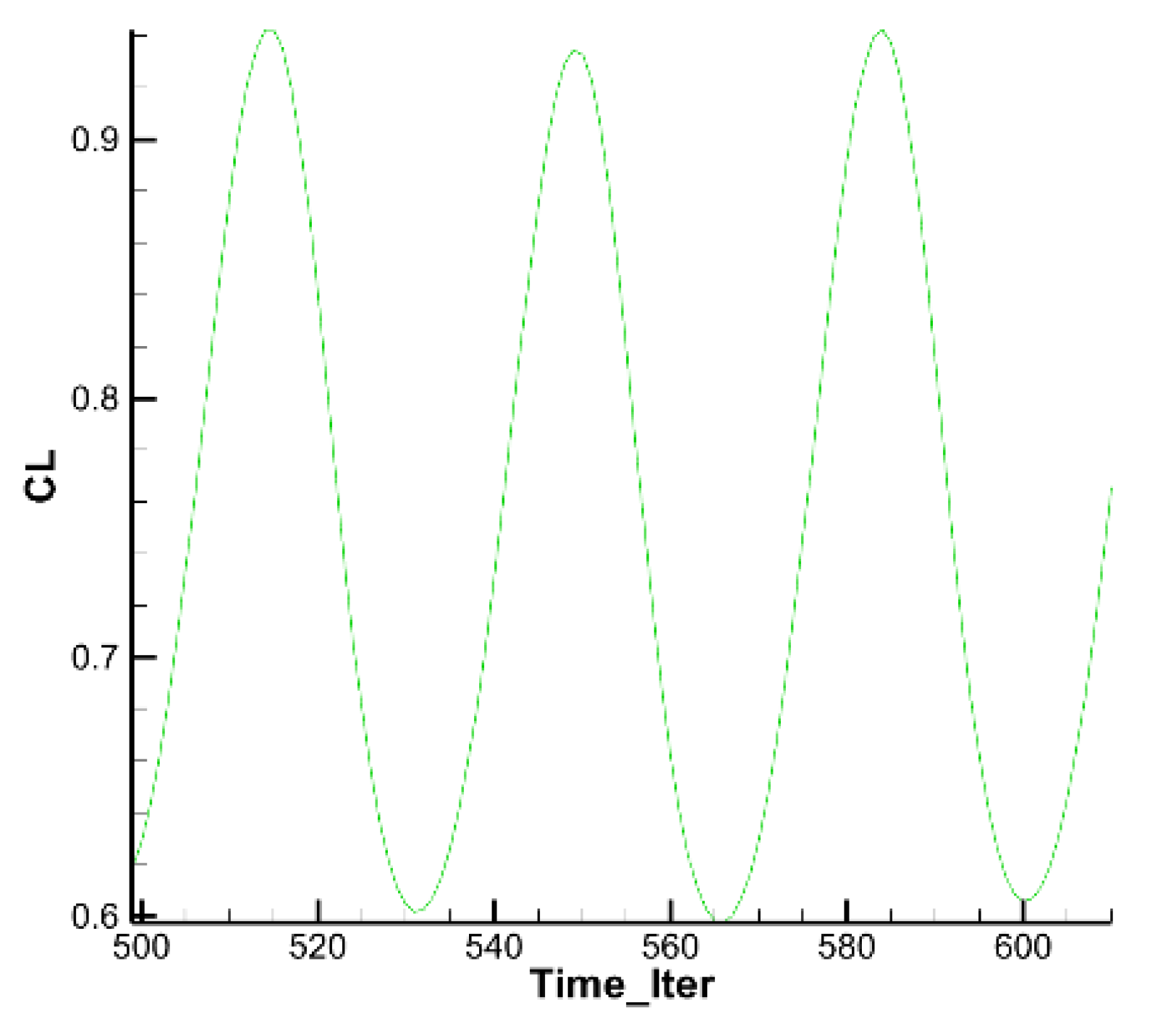
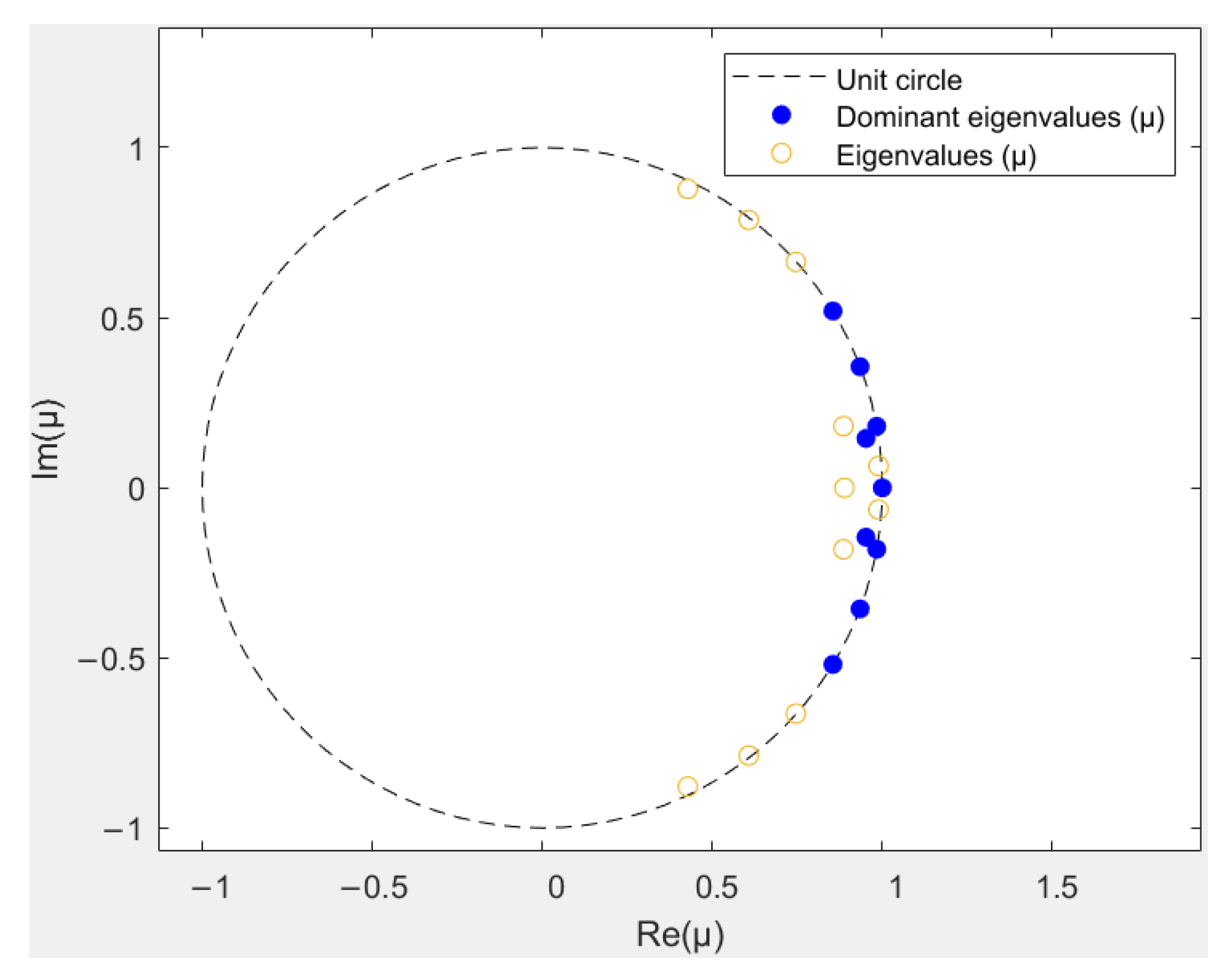
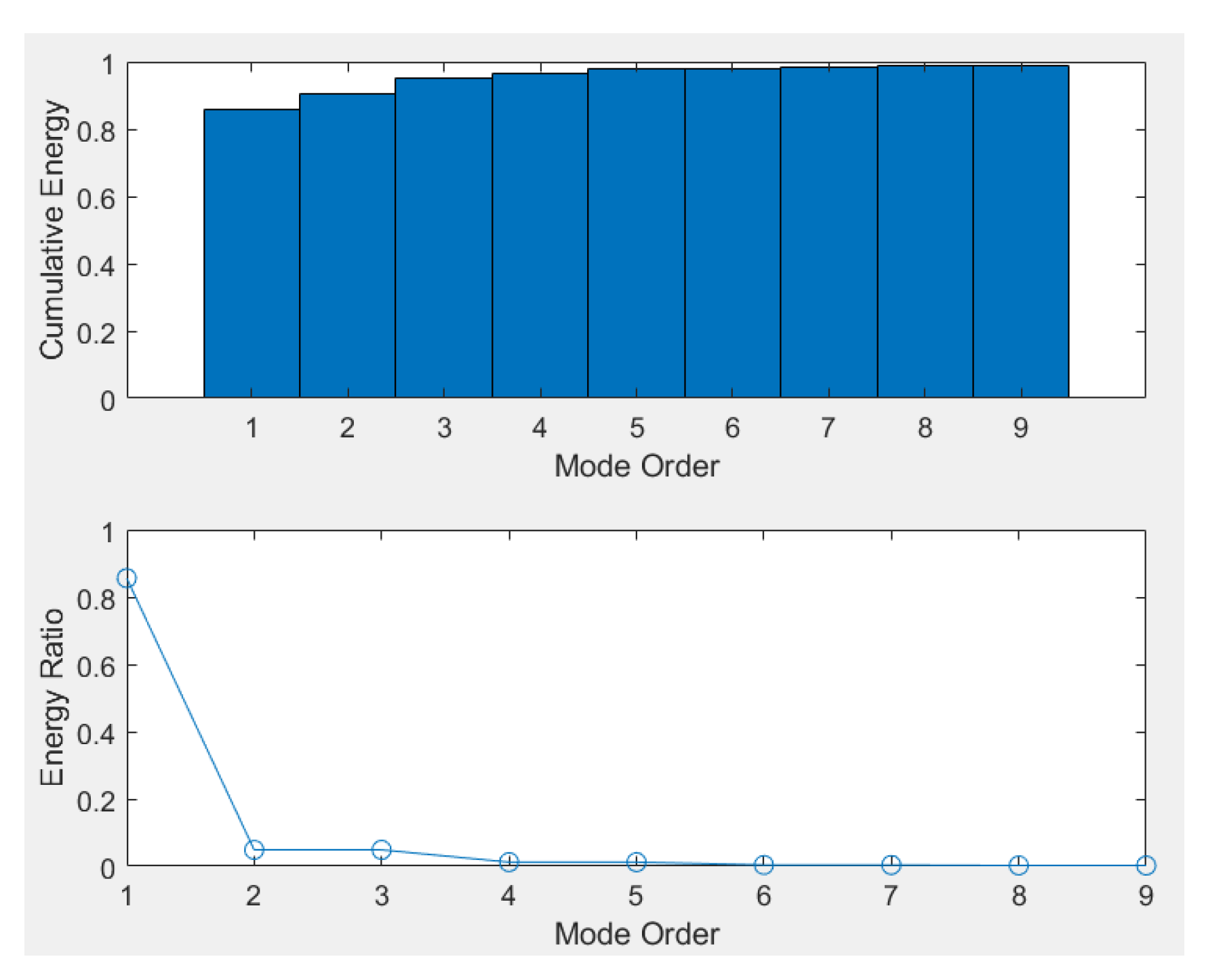

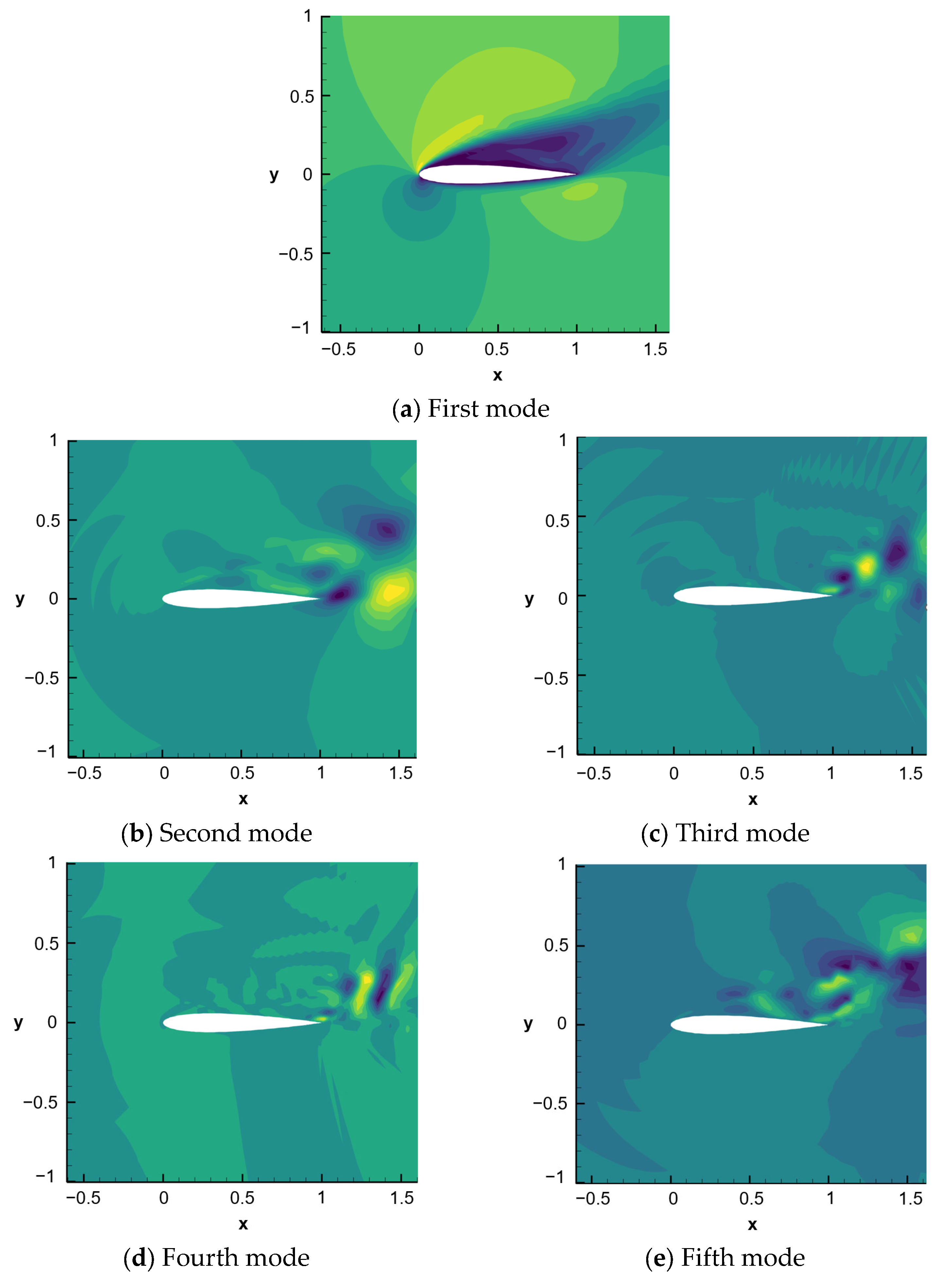
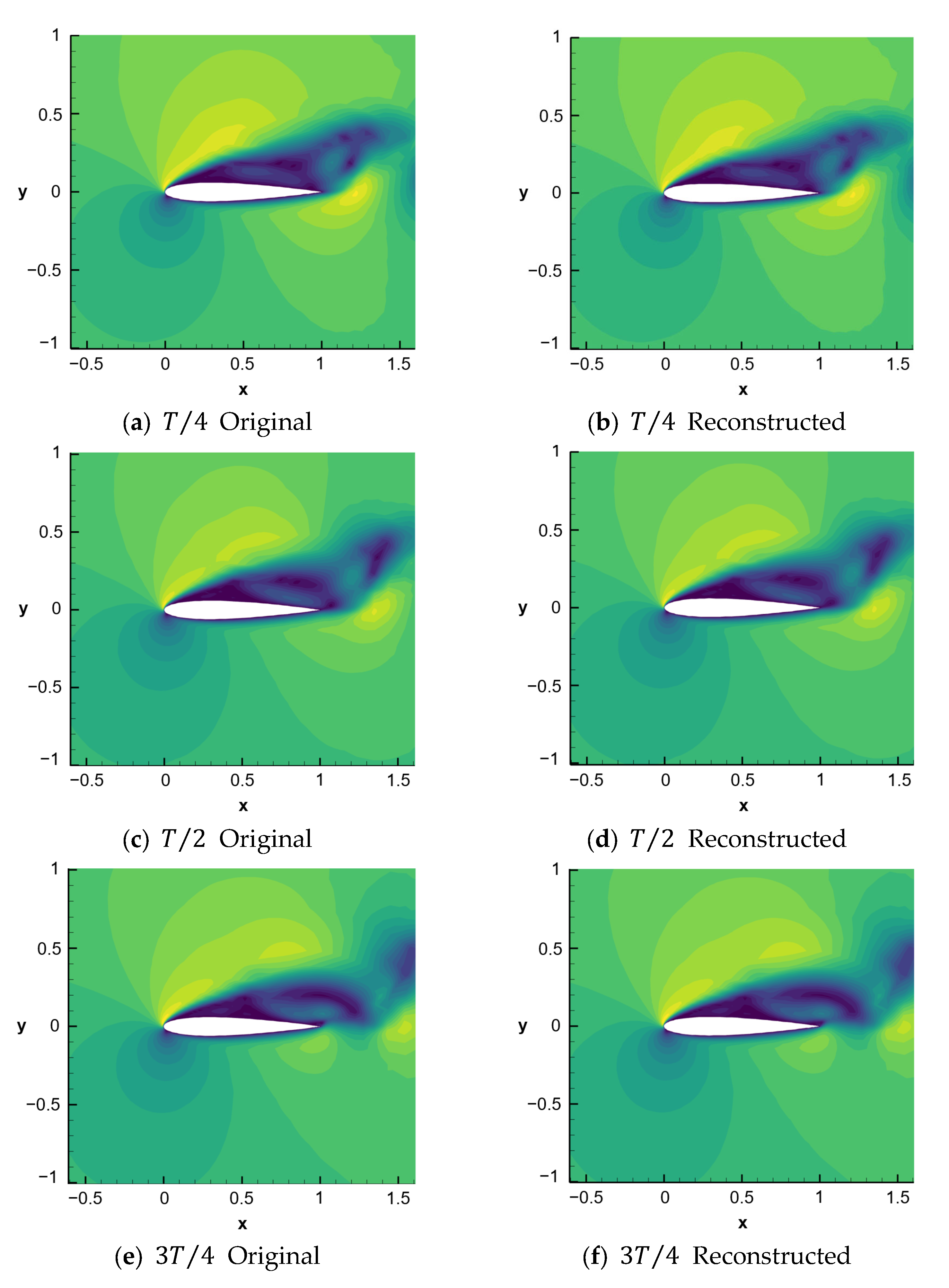
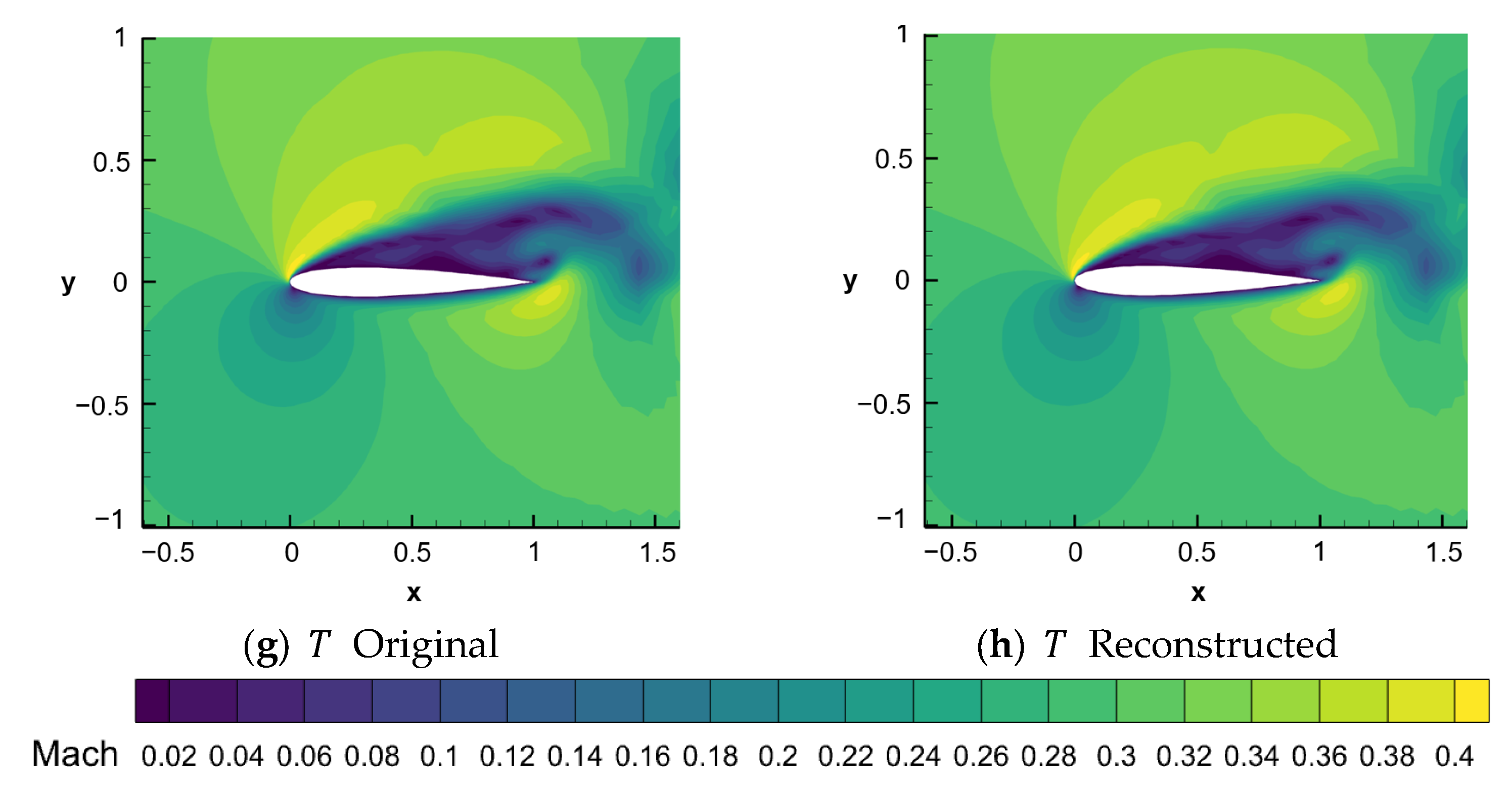
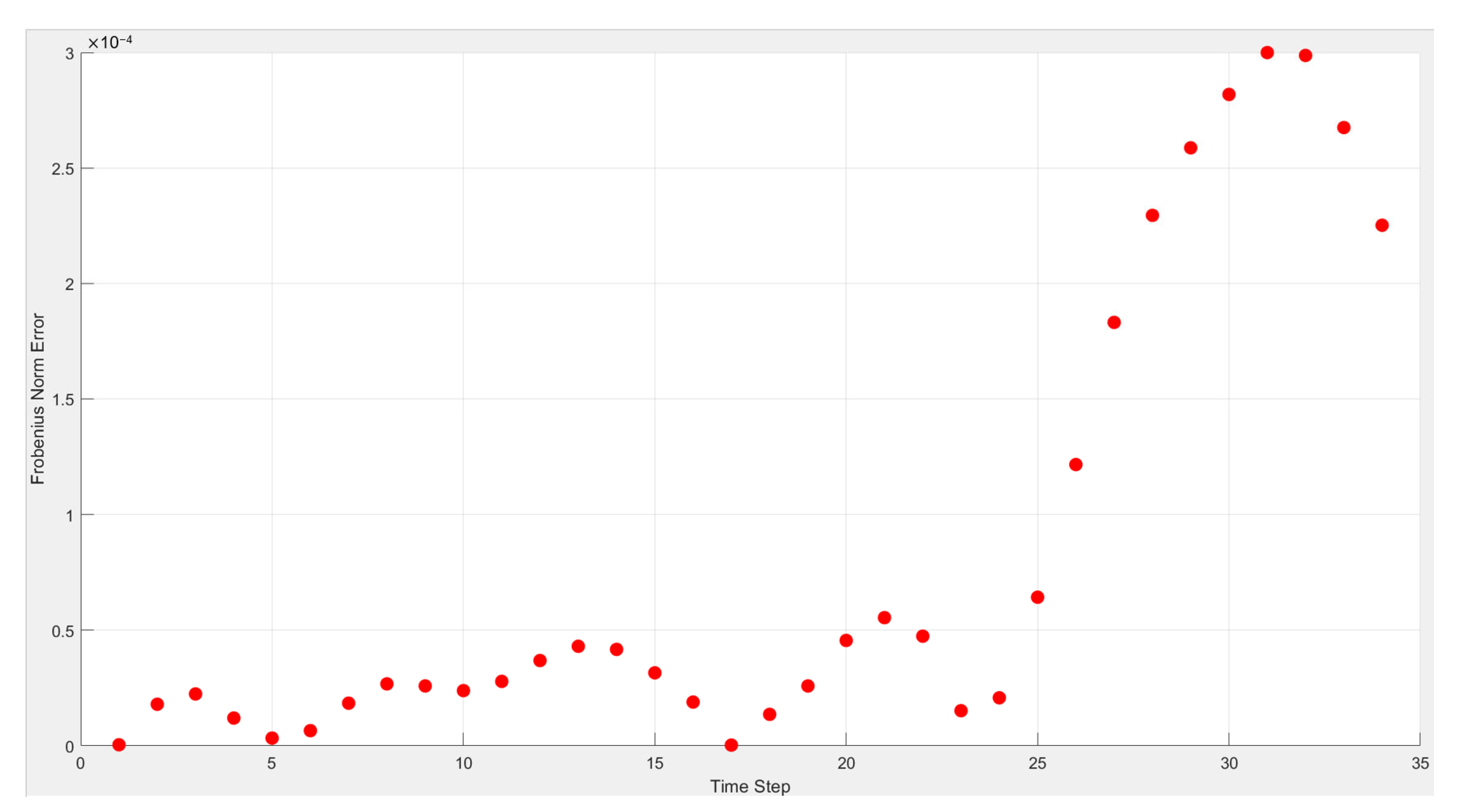
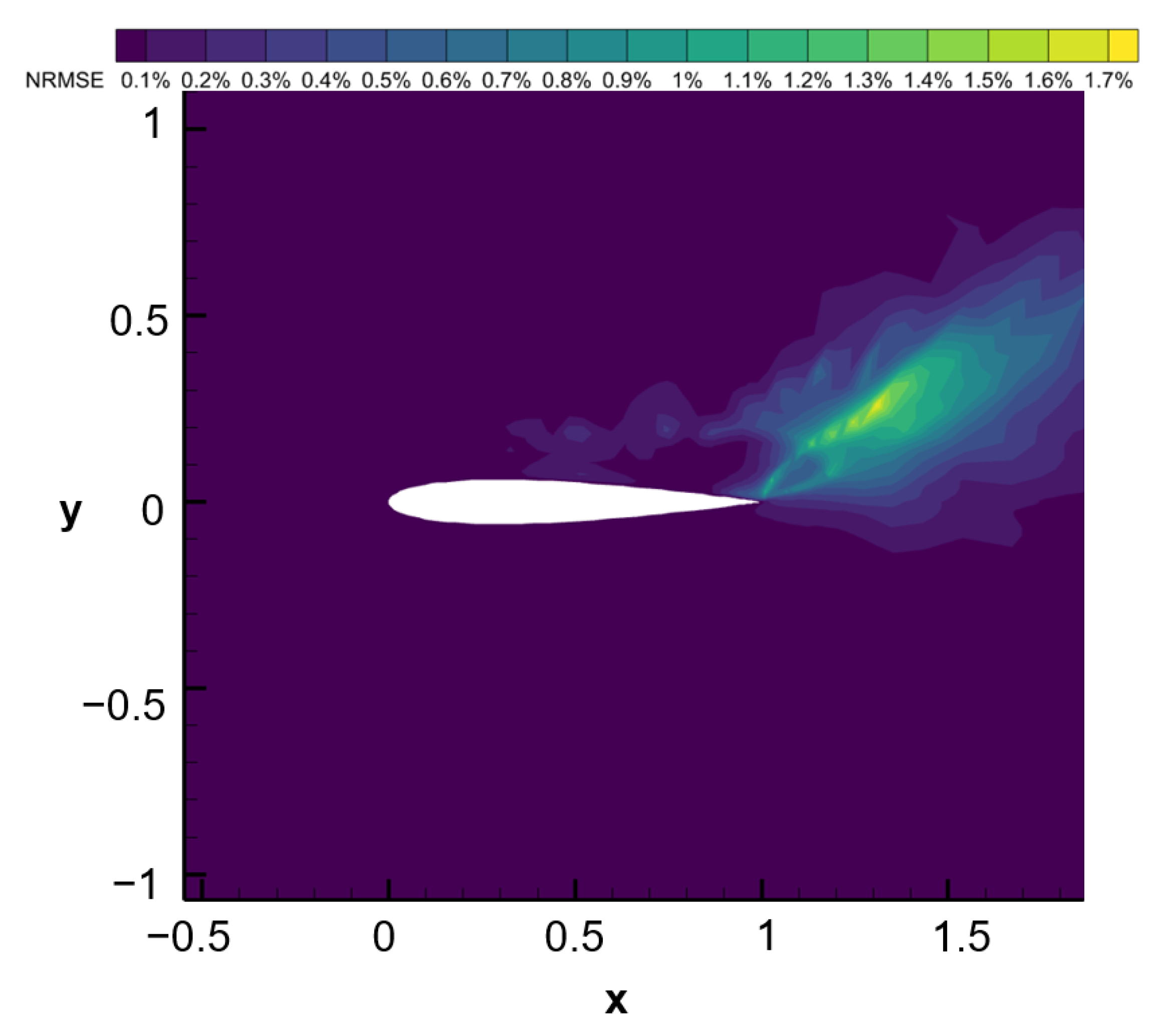



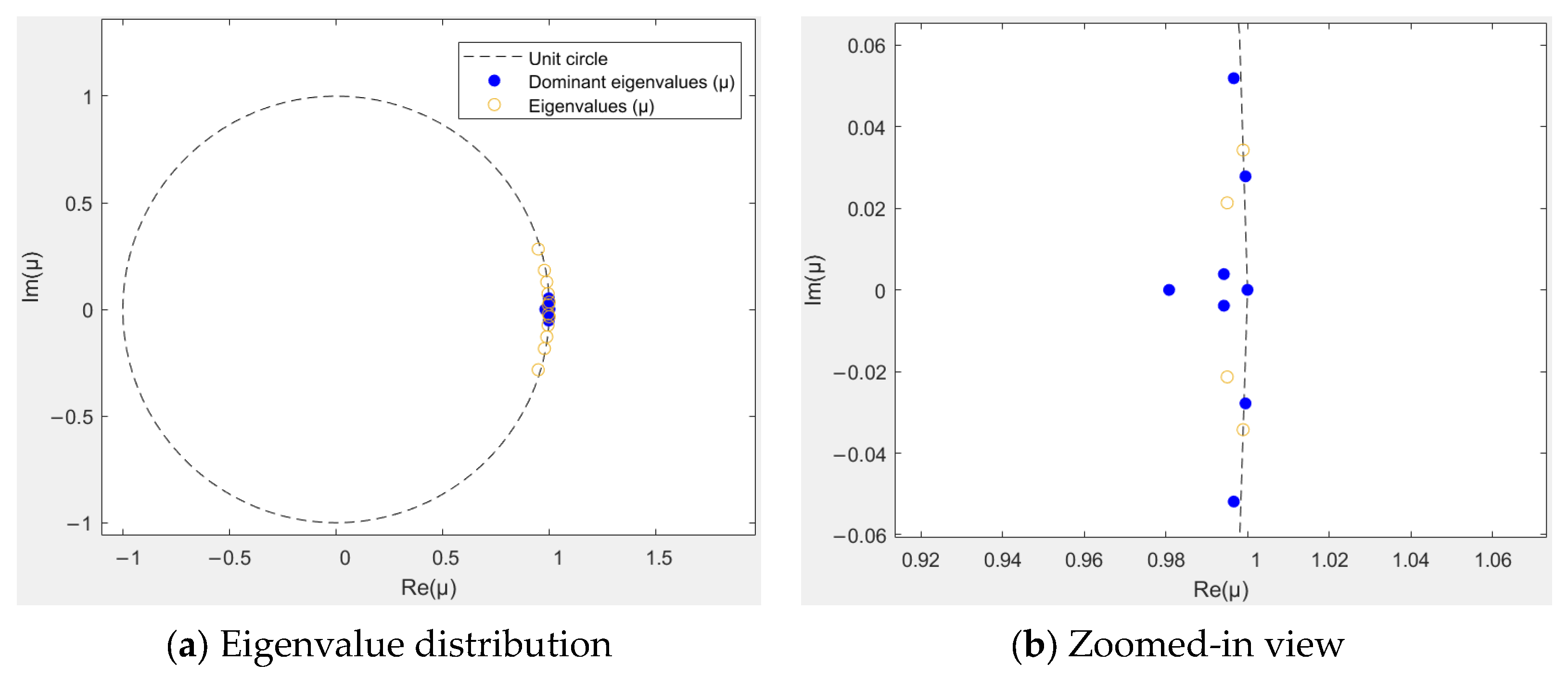
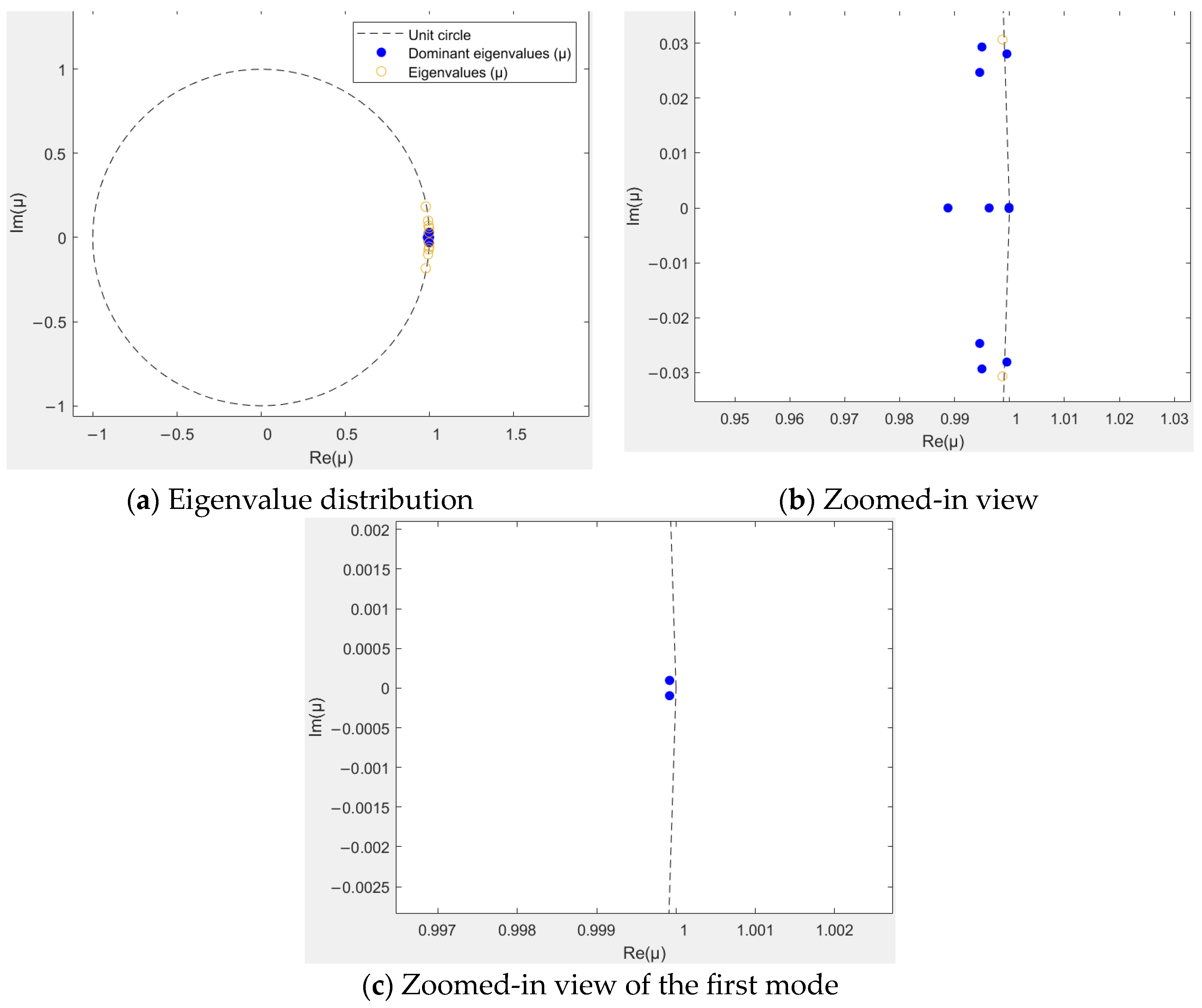
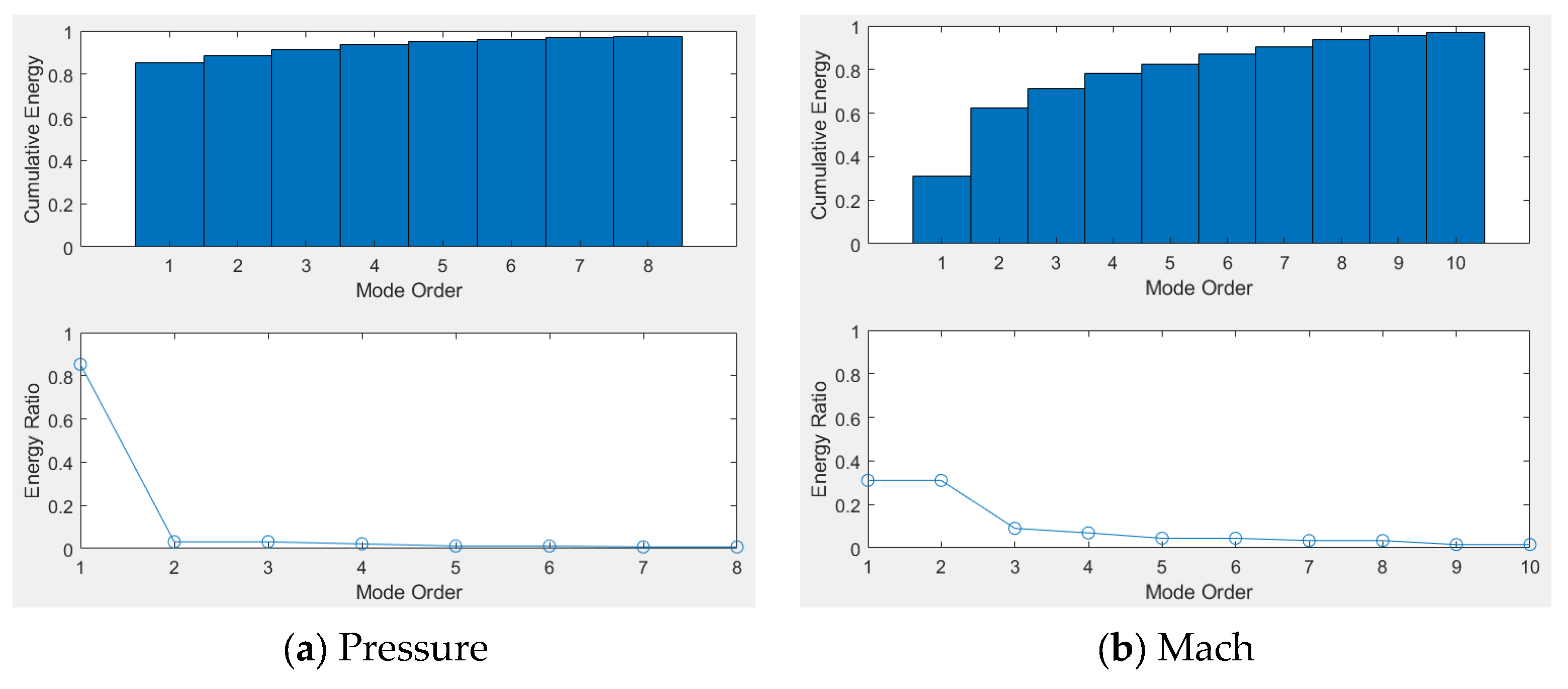
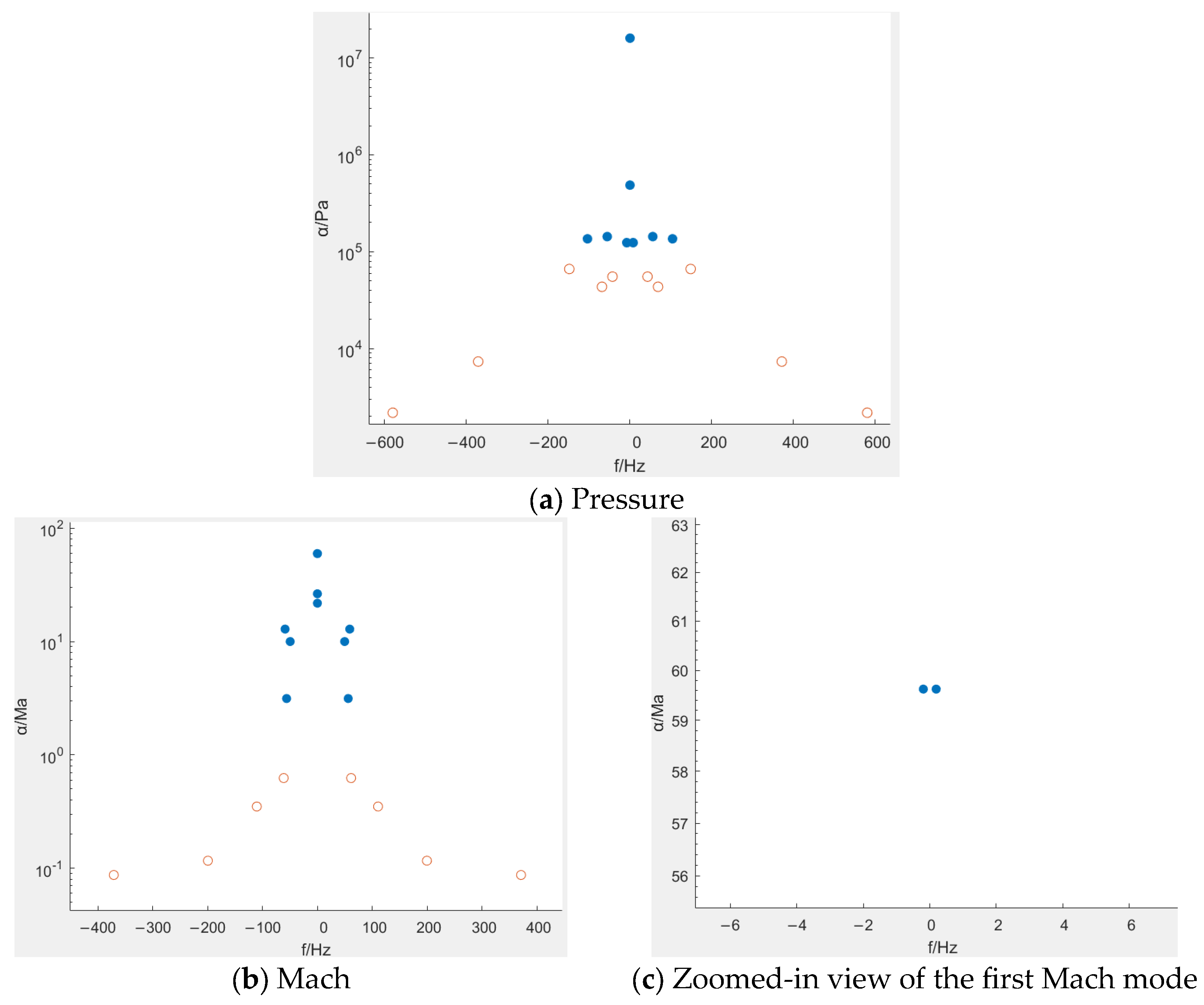
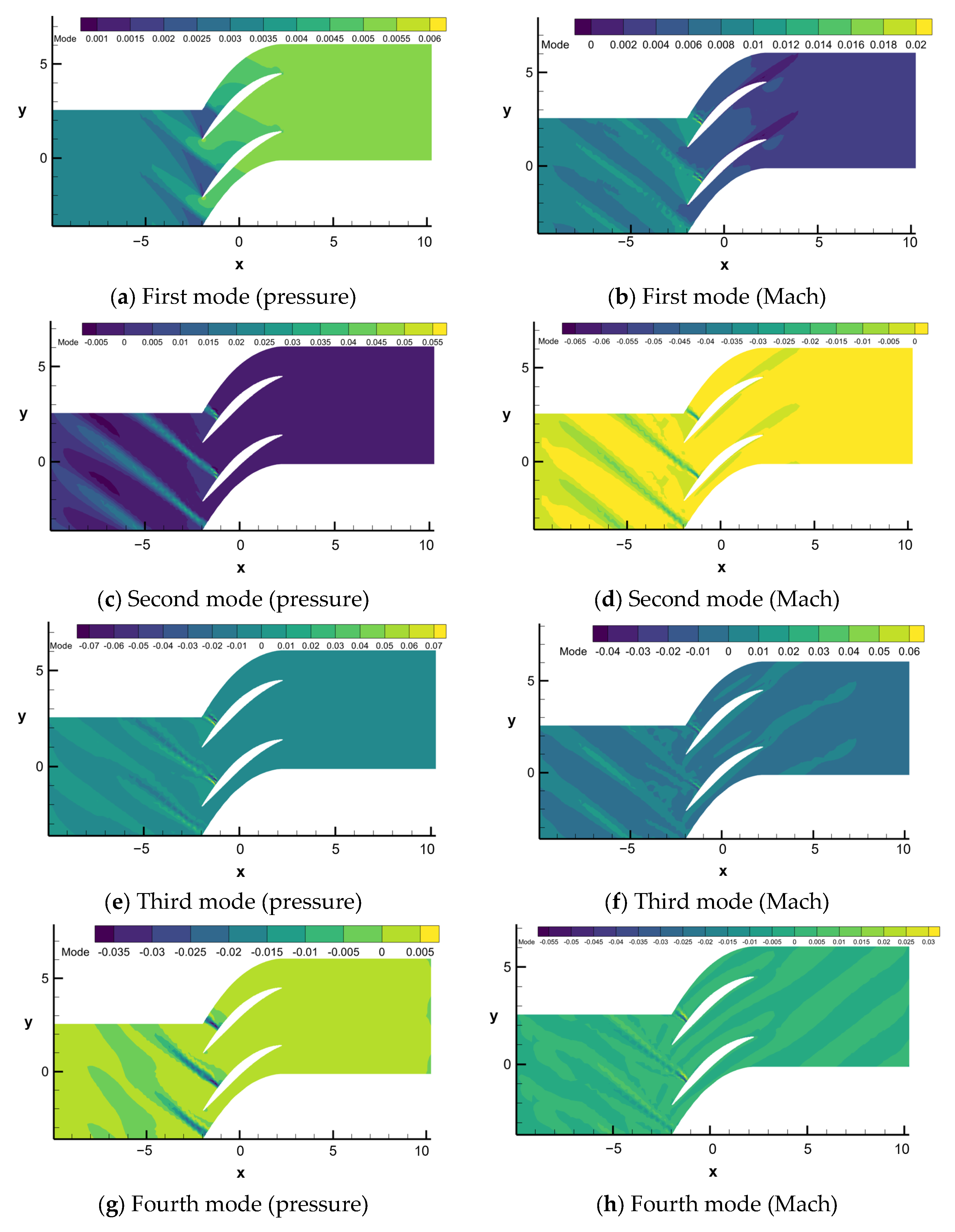

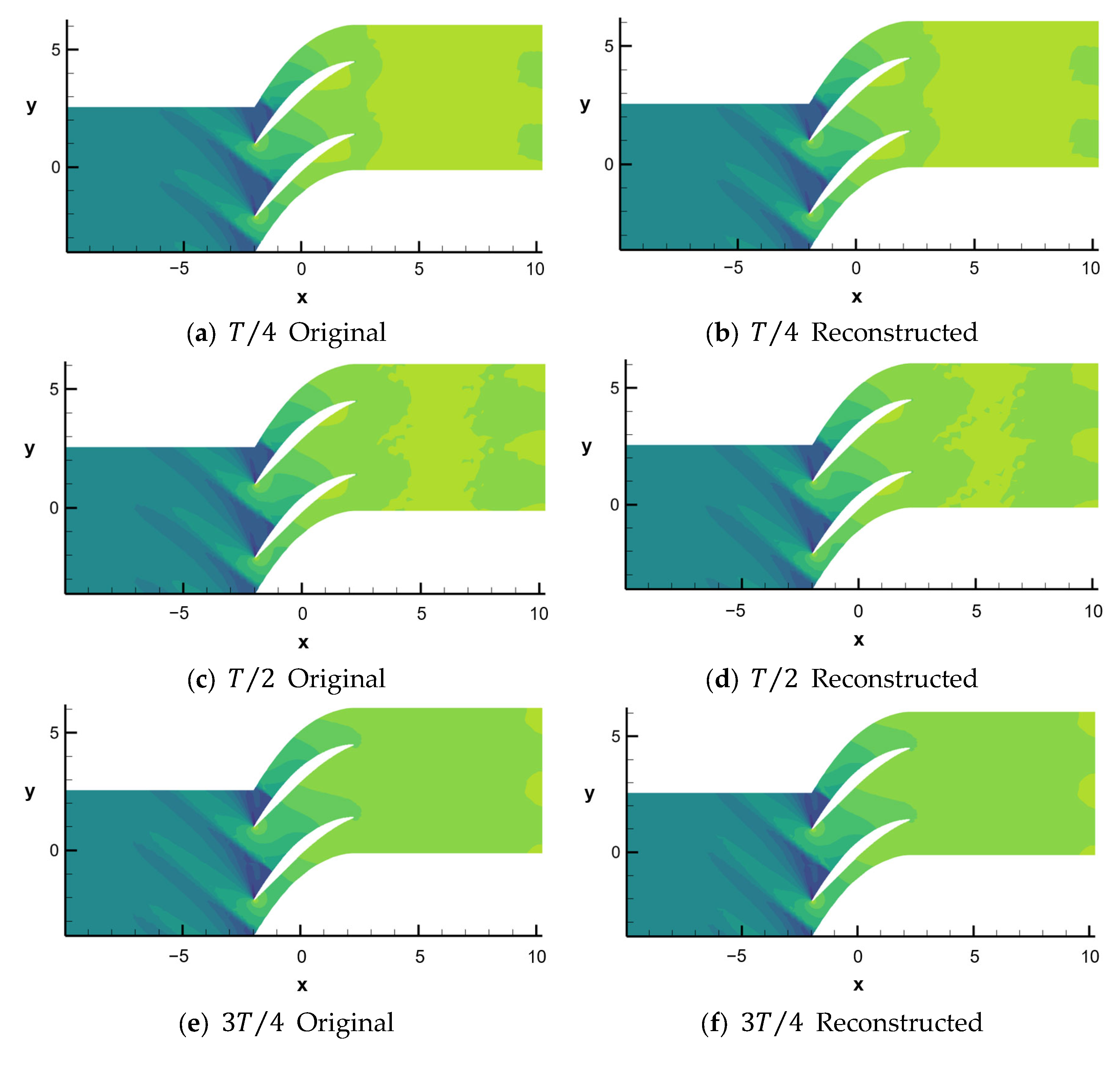
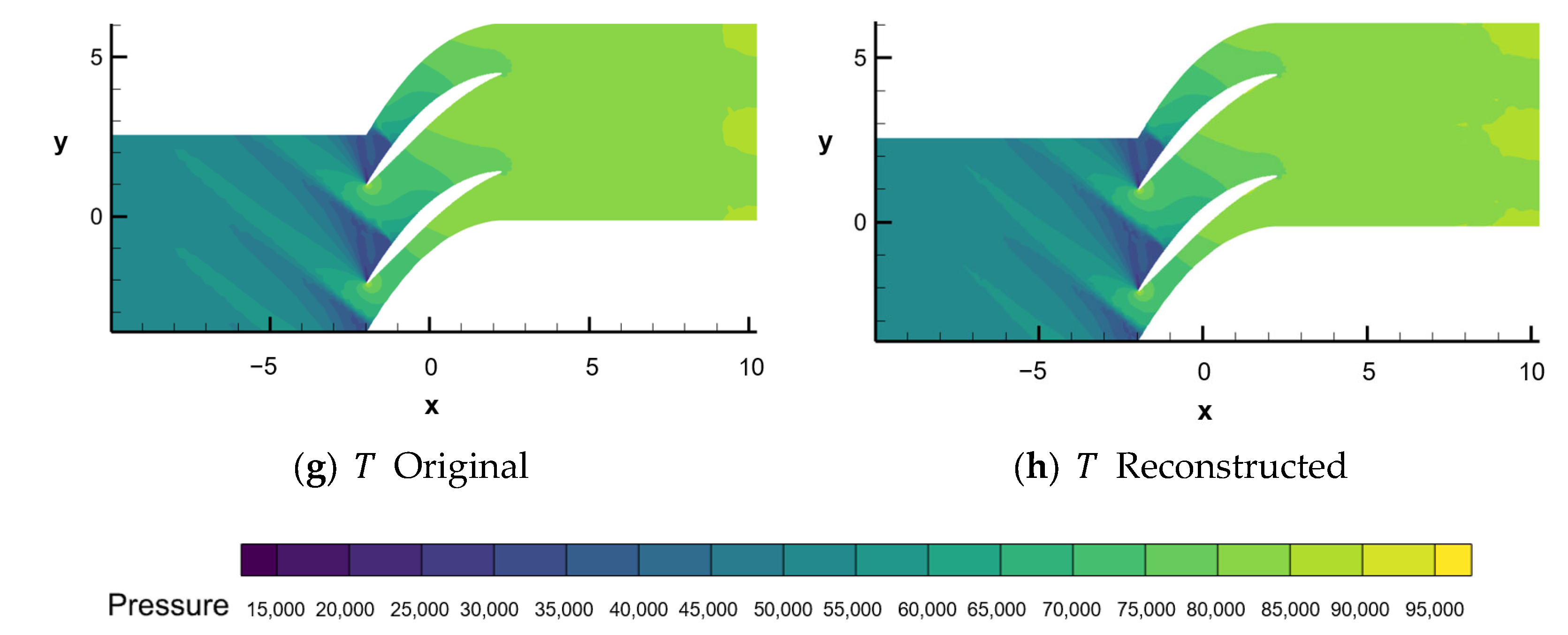
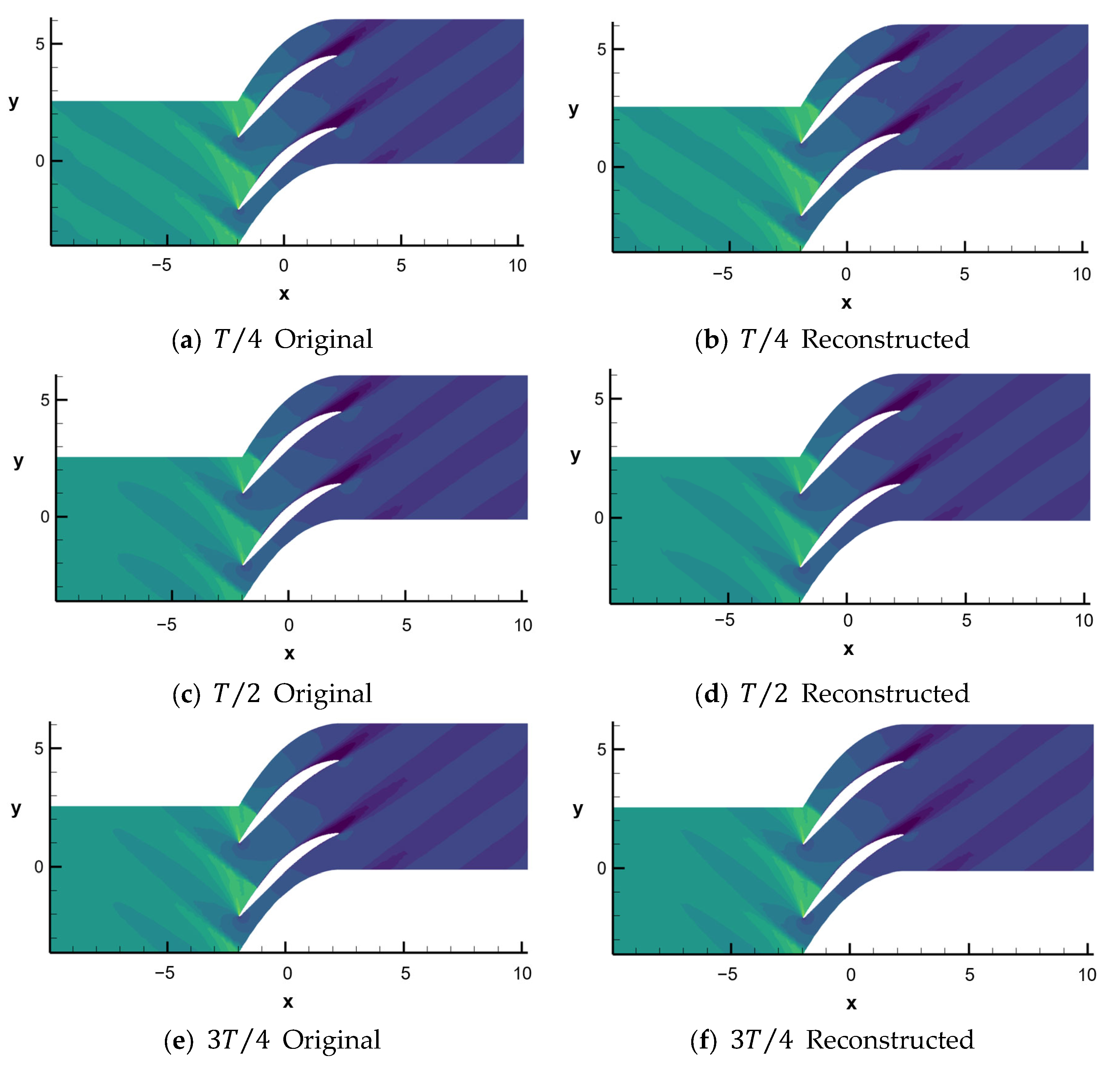

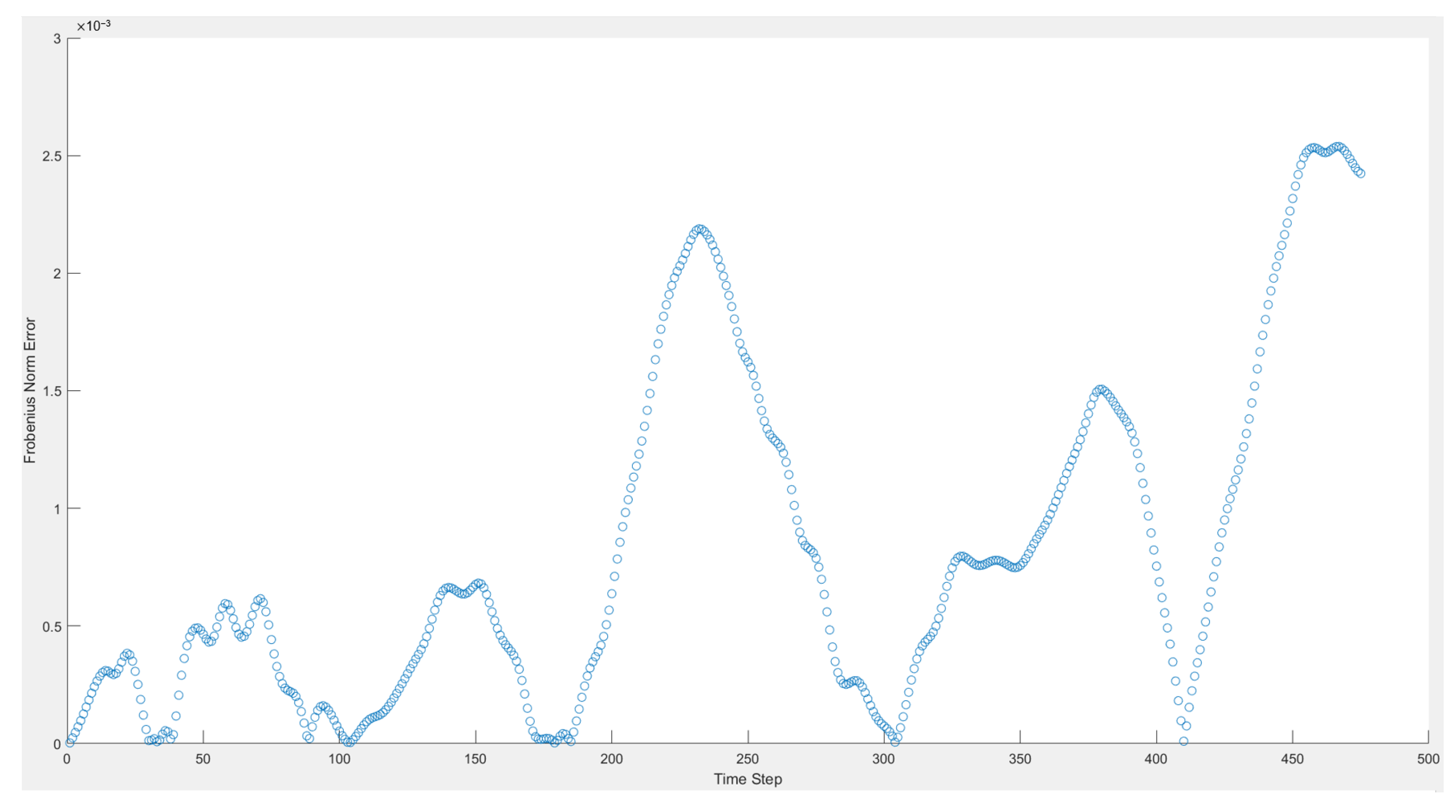
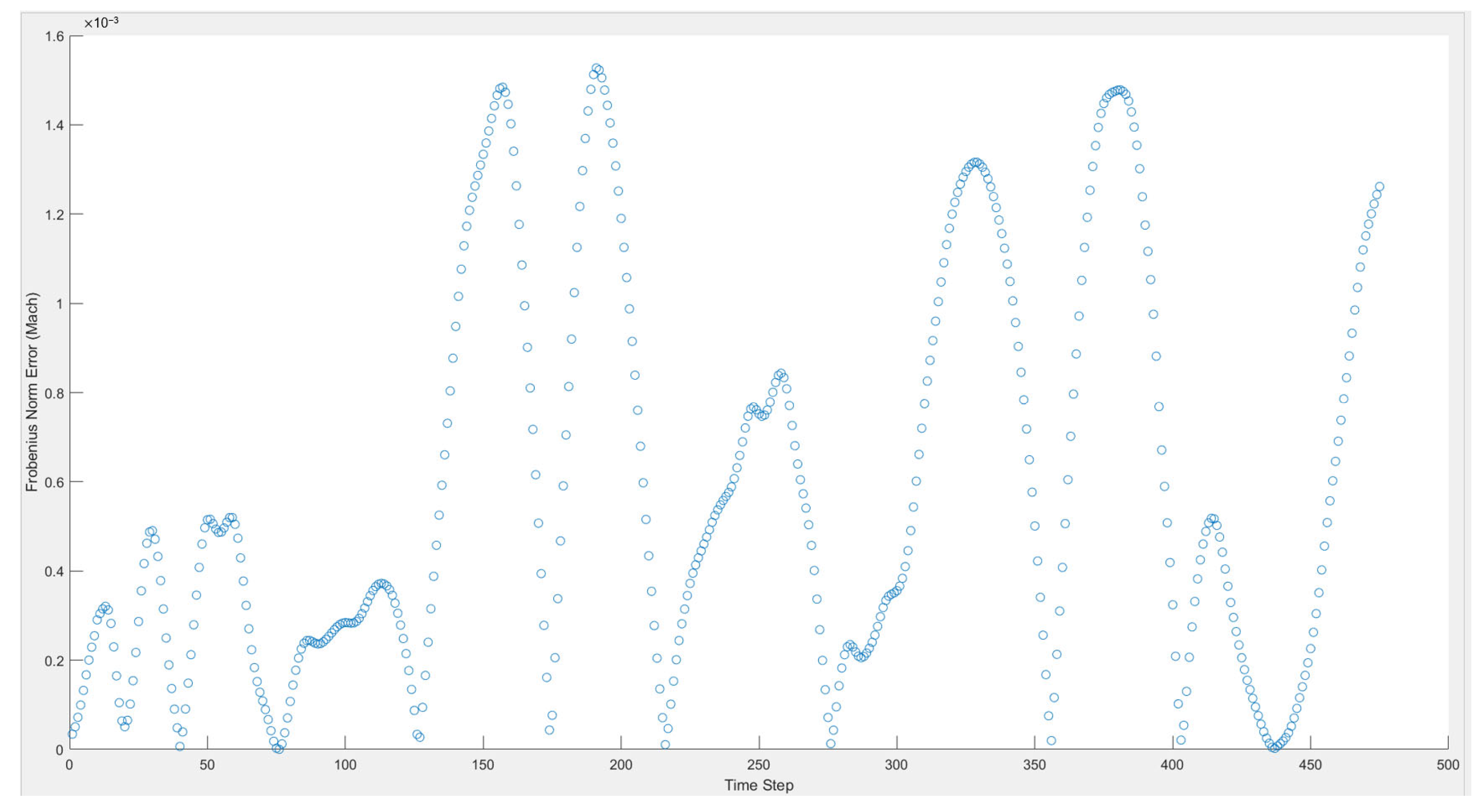

| DMD Mode | Growth Rate | Frequency/kHz |
|---|---|---|
| 1 | 0 | 0 |
| 2 | −0.2432 | 0.3633 |
| 3 | −0.0049 | 0.7279 |
| 4 | 0.1672 | 1.0922 |
| 5 | −75.599 | 0.3028 |
| Inlet Angle | Outlet Angle | Chord | Solidity Rate | Setting Angle | Max Relative Thickness |
|---|---|---|---|---|---|
| 51.69° | 25.7° | 5.622 cm | 1.765 | 41.5° | 0.458 cm |
| DMD Mode | Growth Rate (Pressure) | Frequency/kHz (Pressure) | Growth Rate (Mach) | Frequency/kHz (Mach) |
|---|---|---|---|---|
| 1 | 0 | 0 | −0.1618 | 0.0002 |
| 2 | −11.618 | 0.0078 | −7.4182 | 0 |
| 3 | −38.836 | 0 | −22.530 | 0 |
| 4 | −0.2379 | 0.0557 | −9.2040 | 0.0589 |
| 5 | −4.0631 | 0.1040 | −10.251 | 0.0496 |
| 6 | —— | —— | −0.1782 | 0.0561 |
Disclaimer/Publisher’s Note: The statements, opinions and data contained in all publications are solely those of the individual author(s) and contributor(s) and not of MDPI and/or the editor(s). MDPI and/or the editor(s) disclaim responsibility for any injury to people or property resulting from any ideas, methods, instructions or products referred to in the content. |
© 2024 by the authors. Licensee MDPI, Basel, Switzerland. This article is an open access article distributed under the terms and conditions of the Creative Commons Attribution (CC BY) license (https://creativecommons.org/licenses/by/4.0/).
Share and Cite
Wu, X.; Du, Y. Unsteady Flow Field Analysis of a Compressor Cascade Based on Dynamic Mode Decomposition. Aerospace 2024, 11, 1019. https://doi.org/10.3390/aerospace11121019
Wu X, Du Y. Unsteady Flow Field Analysis of a Compressor Cascade Based on Dynamic Mode Decomposition. Aerospace. 2024; 11(12):1019. https://doi.org/10.3390/aerospace11121019
Chicago/Turabian StyleWu, Xiaoxiong, and Yuming Du. 2024. "Unsteady Flow Field Analysis of a Compressor Cascade Based on Dynamic Mode Decomposition" Aerospace 11, no. 12: 1019. https://doi.org/10.3390/aerospace11121019
APA StyleWu, X., & Du, Y. (2024). Unsteady Flow Field Analysis of a Compressor Cascade Based on Dynamic Mode Decomposition. Aerospace, 11(12), 1019. https://doi.org/10.3390/aerospace11121019






